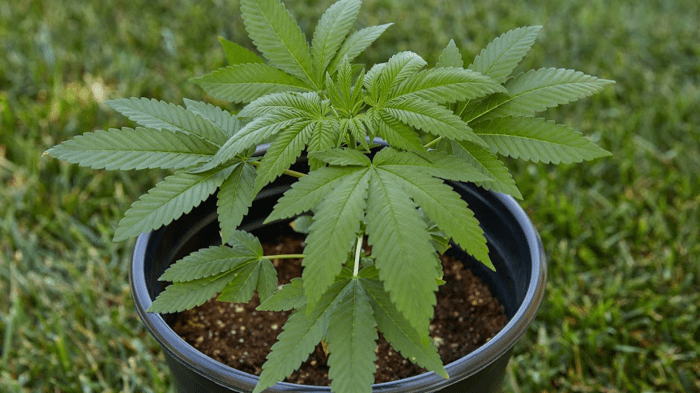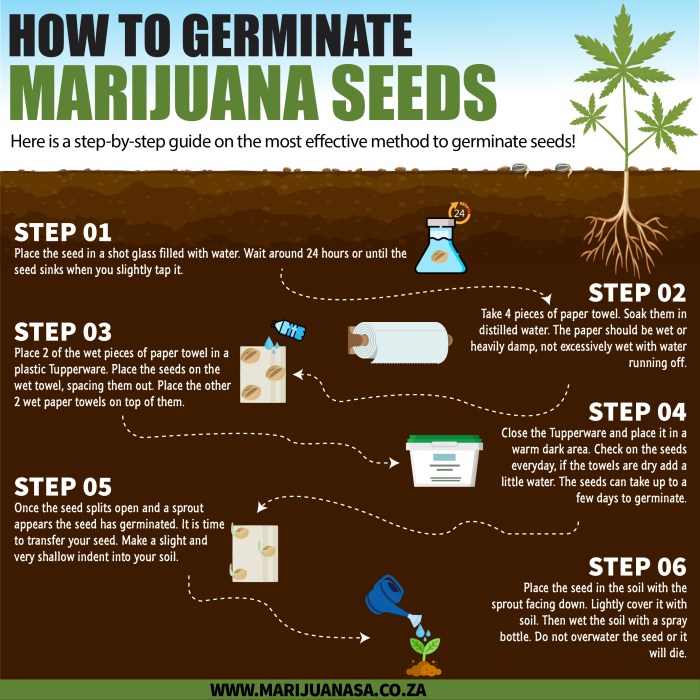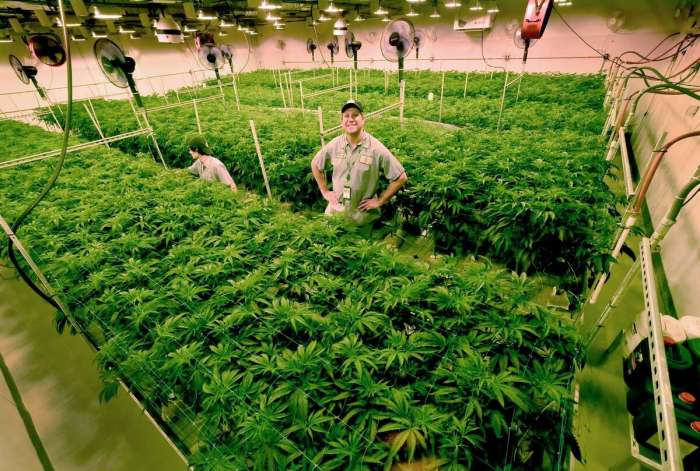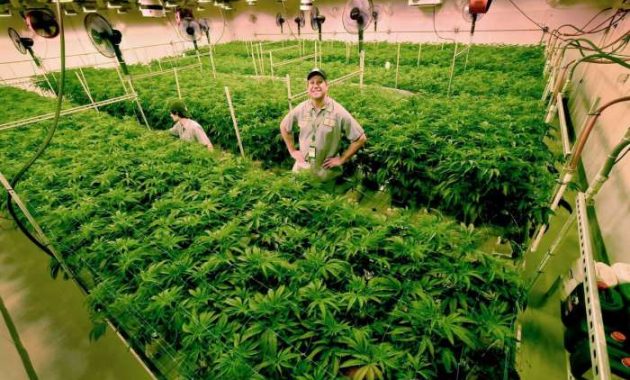Choosing the Right Seeds

How do i plant weed seeds – Selecting the appropriate cannabis seeds is paramount for a successful grow. The characteristics of the seeds, including their genetics and origin, will significantly impact the final product’s yield, potency, and overall quality. Understanding these factors before planting is crucial for achieving your desired results.
Cannabis Seed Strain Characteristics
Different cannabis strains exhibit unique traits influenced by their genetic makeup. These traits affect the plant’s growth pattern, flowering time, aroma, flavor profile, and the type of high produced. Understanding these variations is essential for choosing seeds that align with your growing preferences and experience level. For example, some strains are known for their resilience to pests and diseases, making them ideal for novice growers.
The clandestine act of sowing weed seeds, a ritual shrouded in secrecy, demands precision. Timing is everything; much like the crucial decision of when to plant your orchard, a choice that determines the bounty of your harvest. To ensure a bountiful yield, research the best time to plant pear trees , mirroring the careful consideration needed for your illicit crop.
The soil’s embrace, the sun’s kiss – these factors dictate success, whether you cultivate pears or something far more forbidden.
Others might require more specialized care and attention. Detailed descriptions of specific strains are often available from reputable seed banks, providing valuable information on expected yields, flowering times, and potential effects.
Indica, Sativa, and Hybrid Seeds: A Comparison
Cannabis strains are broadly categorized into three main types: Indica, Sativa, and Hybrid. Indica strains are generally known for their shorter, bushier growth patterns and relaxing, body-focused effects. Sativa strains, conversely, tend to be taller and more slender, producing a more uplifting and energetic high. Hybrid strains combine the characteristics of both Indica and Sativa parents, resulting in a wide range of phenotypes with varying effects and growth patterns.
The ratio of Indica to Sativa genetics in a hybrid will significantly influence its overall characteristics. For example, a 60/40 Indica-dominant hybrid might exhibit more Indica-like traits, such as shorter stature and a more relaxing effect, while a 50/50 hybrid might display a more balanced combination of both.
Seed Source and Quality
The source and quality of your seeds are critical factors influencing germination rates and overall plant health. Reputable seed banks prioritize quality control, ensuring their seeds are viable, free from diseases, and accurately labeled. Purchasing seeds from unreliable sources increases the risk of receiving low-quality, non-viable seeds or seeds that do not match the advertised strain. Furthermore, seeds from reputable sources often come with detailed information about the strain’s genetics, growth characteristics, and expected yield, aiding in informed decision-making.
Investing in high-quality seeds from a trusted source significantly increases the chances of a successful harvest.
Checking Seed Viability
Before planting, it’s advisable to check the viability of your seeds to determine which ones are likely to germinate. A simple method involves placing the seeds in a glass of water. Viable seeds will typically sink to the bottom, while non-viable seeds will float. This method is not foolproof, but it provides a preliminary assessment of seed quality.
Seeds that sink may still fail to germinate, but floating seeds are almost certainly non-viable. Another method involves gently squeezing the seed between your fingers; a viable seed will feel firm and full, while a non-viable seed will feel soft or empty. This method is less reliable than the water test but provides additional information about the seed’s condition.
Germination Methods

Successfully sprouting your cannabis seeds requires understanding the optimal conditions for germination. Two primary methods exist: paper towel germination and direct sowing into soil. Each approach presents unique advantages and disadvantages, influencing germination success rate and the overall speed of the process. Choosing the right method depends on your experience level and the specific circumstances of your grow operation.
Paper Towel Germination
Paper towel germination offers a controlled environment to monitor seed progress closely. This method is ideal for beginners, allowing for easy observation of root development and identification of any issues early on. The process involves placing seeds between damp paper towels, ensuring they remain moist but not waterlogged, to stimulate germination.
- Place two paper towels in a shallow, sealable container. Thoroughly dampen the towels with lukewarm, pH-balanced water (ideally around 6.0-7.0). Avoid over-saturating; the towels should be moist, not dripping.
- Gently place your cannabis seeds between the damp paper towels, ensuring they are not touching each other. Spacing prevents mold growth and ensures each seed has sufficient access to moisture and oxygen.
- Seal the container, creating a humid environment that mimics the conditions found underground. Place the container in a dark, warm location with a consistent temperature between 70-80°F (21-27°C).
- Monitor the seeds daily. Keep the paper towels moist by lightly misting with water as needed. Avoid letting the towels dry out completely, which can hinder germination.
- Once the seeds have sprouted a taproot (usually within 3-7 days), they are ready to be transplanted into your growing medium. Gently handle the seedlings to avoid damaging the delicate root system.
Direct Sowing into Soil
Direct sowing involves planting seeds directly into your chosen growing medium. This method is quicker and potentially less stressful for the seedlings, eliminating the need for transplanting. However, it requires a more experienced hand and careful attention to soil moisture and temperature.
- Select a well-draining potting mix specifically formulated for cannabis or seedlings. The soil should be moist but not soggy.
- Create small holes in the soil, approximately ¼ inch deep. Space the holes appropriately based on the size of your containers and the expected growth of the plants.
- Carefully place one seed in each hole, ensuring the seed is buried correctly. Cover the hole with soil, gently patting it down to ensure good seed-to-soil contact.
- Water the soil thoroughly but gently, avoiding dislodging the seeds. Ensure consistent moisture levels throughout the germination period.
- Maintain a warm and consistent temperature, similar to the paper towel method (70-80°F or 21-27°C). Provide adequate indirect light, as direct sunlight can be too harsh for newly germinated seedlings.
Comparison of Germination Methods
Paper towel germination offers greater control and allows for early detection of non-viable seeds. Direct sowing is faster and avoids the potential transplant shock. However, direct sowing requires a more experienced grower due to the higher risk of fungal growth or seed rot if the soil conditions are not ideal.
| Method | Success Rate | Time to Germination | Difficulty Level |
|---|---|---|---|
| Paper Towel | 80-95% | 3-7 days | Easy |
| Direct Sowing | 70-85% | 5-10 days | Medium |
Planting Medium and Container Selection: How Do I Plant Weed Seeds
Choosing the right planting medium and container is crucial for successful cannabis cultivation. The medium provides essential nutrients and supports healthy root development, while the container dictates the plant’s growth space and influences drainage. Selecting the appropriate combination ensures optimal growth and minimizes the risk of common cultivation problems.The ideal planting medium for cannabis seeds offers a balance of water retention, aeration, and drainage.
It should be loose enough to allow for adequate root penetration and oxygen flow, yet retain enough moisture to prevent drying out. A mix that’s too dense can lead to root rot, while one that’s too loose can result in inconsistent watering and nutrient uptake. The pH level of the medium should also be carefully monitored, as cannabis thrives in a slightly acidic environment (around 6.0-7.0).
Drainage and Aeration Importance, How do i plant weed seeds
Proper drainage and aeration are paramount for healthy root development. Poor drainage leads to waterlogging, which deprives roots of oxygen and creates an environment conducive to fungal diseases like root rot. Conversely, insufficient aeration restricts root growth and nutrient uptake, hindering the plant’s overall health and yield. A well-draining medium with ample air pockets ensures that roots receive the necessary oxygen for respiration and nutrient absorption.
This can be achieved through the use of perlite, vermiculite, or coco coir, which are often incorporated into soil mixes to improve drainage and aeration. For example, a typical soil mix might consist of 70% potting soil, 20% perlite, and 10% vermiculite. This combination provides a balance of nutrient richness, drainage, and aeration.
Planting Container Comparison
Various containers are suitable for growing cannabis, each with its advantages and disadvantages. Pots offer flexibility in size and portability, making them ideal for smaller grows or for plants that need to be transplanted. However, they can dry out faster than other options, requiring more frequent watering. Trays, on the other hand, are often used for starting seeds or for propagating cuttings.
They provide a more controlled environment and can be easily watered from below. Larger containers, such as fabric pots, are advantageous for larger plants, as they allow for better root aeration and prevent root-bound issues. The choice of container ultimately depends on the size and type of grow operation, as well as the specific needs of the cannabis plants.
Simple Indoor Grow Setup
A simple indoor grow setup can be created using readily available materials. For example, a standard plastic storage container can serve as a grow tray. Fill the container with a well-draining soil mix (as described above), and plant seeds or seedlings in small pots placed within the tray. This allows for easy bottom watering and maintains consistent moisture levels.
A simple grow light, such as a fluorescent or LED bulb, can be positioned above the plants, providing the necessary light for growth. Maintaining proper temperature and humidity levels is also important and can be managed using a thermometer and hygrometer, readily available at most garden centers. This setup provides a basic, cost-effective method for successfully growing cannabis indoors.
Remember to ensure adequate ventilation to prevent mold and mildew growth.
Planting and Seedling Care
Successfully germinating cannabis seeds is only half the battle. Proper planting and consistent care during the seedling stage are crucial for healthy growth and a bountiful harvest. This section details the techniques for planting your seedlings and nurturing them through their vulnerable early stages. Careful attention to detail during this period will significantly impact the overall health and yield of your plants.Planting Depth and SpacingThe ideal planting depth for cannabis seeds is generally about ½ inch (1.3 cm).
Burying them too deeply can hinder germination, while planting them too shallowly leaves them vulnerable to drying out. Spacing depends on the chosen growing method. For individual pots, allow ample space for root development; a 3-inch (7.6 cm) pot is suitable for a seedling until it’s ready for transplanting. In larger containers or directly in the ground, aim for 12-18 inches (30-46 cm) between plants to prevent overcrowding and competition for resources.Consistent Moisture LevelsMaintaining consistent moisture is paramount for seedling success.
Cannabis seedlings are particularly sensitive to drying out, which can lead to wilting and death. Conversely, overwatering can cause root rot. The soil should be kept consistently moist, but not waterlogged. A well-draining planting medium is essential to prevent water retention and promote healthy root growth. Using a moisture meter can help monitor soil conditions.Watering and Feeding Schedule for SeedlingsDuring the first few weeks, seedlings require frequent but gentle watering.
Avoid overwatering, which can lead to damping-off (a fungal disease). Water when the top inch of soil feels dry. As seedlings develop their first true leaves, you can start introducing a diluted nutrient solution. A nutrient solution specifically formulated for seedlings is recommended. Begin with a concentration of approximately ¼ to ½ the strength recommended for mature plants.
Gradually increase the concentration as the plants grow. A typical feeding schedule might be every other watering, but always monitor the plants’ appearance and adjust accordingly.Common Seedling Problems and SolutionsSeedlings are vulnerable to various issues. Addressing these problems promptly is crucial for plant survival.
- Problem: Damping-off (fungal disease causing stem rot and wilting).
Solution: Ensure good air circulation, avoid overwatering, and use a sterile planting medium. A fungicide may be necessary in severe cases. - Problem: Nutrient deficiencies (yellowing leaves, stunted growth).
Solution: Use a balanced seedling nutrient solution and adjust the pH of your watering solution. Soil testing can help determine specific deficiencies. - Problem: Pests (aphids, spider mites).
Solution: Inspect plants regularly for pests. Treat infestations promptly with insecticidal soap or other appropriate pest control methods. Introducing beneficial insects can also help control pests organically. - Problem: Overwatering (wilting, yellowing leaves, root rot).
Solution: Allow the soil to dry out slightly between waterings. Ensure good drainage in your containers. Consider transplanting if root rot is suspected. - Problem: Underwatering (wilting, drooping leaves).
Solution: Water thoroughly when the top inch of soil feels dry. Increase watering frequency during hot, dry periods. Consider adding mulch to retain moisture.
Troubleshooting

Successfully germinating and nurturing cannabis seedlings requires vigilance. Various issues can arise, hindering growth and potentially leading to crop failure. Understanding these challenges and implementing proactive solutions is crucial for a healthy harvest. This section details common problems, their causes, and effective remedies.
Damping-Off
Damping-off is a devastating fungal disease affecting seedlings, causing them to wilt and collapse at the soil line. This is often due to overly wet conditions and poor air circulation. The fungi thrive in moist environments, attacking the tender stems of young plants. Symptoms include wilting, discoloration, and rotting at the base of the stem. Prevention is key.
Using a well-draining potting mix, avoiding overwatering, and ensuring adequate ventilation are crucial preventative measures. If damping-off occurs, removing affected seedlings immediately and treating the remaining plants with a fungicide may help contain the spread. Sterilizing your growing medium and containers before use can also prevent future outbreaks.
Nutrient Deficiencies and Excesses
Cannabis plants, like all plants, require a balanced supply of essential nutrients for healthy growth. Nutrient deficiencies manifest in various ways, depending on the specific nutrient lacking. For instance, nitrogen deficiency leads to stunted growth and yellowing of older leaves, while phosphorus deficiency results in dark green or purplish leaves and slow growth. Conversely, nutrient excesses can also be detrimental.
Over-fertilization can lead to “burnt” tips on leaves, yellowing, and stunted growth. Careful monitoring of nutrient levels, using a soil testing kit, and following recommended feeding schedules are essential. Adjusting the nutrient solution accordingly, based on the observed symptoms and test results, is crucial for optimal plant health.
Pest and Disease Prevention
Various pests and diseases can attack cannabis plants at all growth stages. Common pests include aphids, spider mites, and whiteflies. These can be controlled through preventative measures such as maintaining good hygiene, regular inspection, and the use of beneficial insects or organic pesticides. Diseases such as powdery mildew and gray mold can also affect cannabis plants, thriving in humid environments.
Good air circulation, avoiding overhead watering, and the use of appropriate fungicides can help prevent these issues. Regularly inspecting plants for signs of pests or diseases allows for early intervention, minimizing potential damage. Proactive measures are far more effective than reactive ones in protecting your crop.
Visual Guide: Seedling Development
Understanding the visual cues of cannabis seedling development is crucial for ensuring healthy growth and a successful harvest. Monitoring your seedlings allows for early detection of problems and timely intervention. The following stages Artikel the typical progression, highlighting key characteristics of healthy and unhealthy plants.
Cotyledon Emergence
The first visible sign of germination is the emergence of the cotyledons, also known as seed leaves. These are the first leaves to appear, providing initial nourishment to the seedling until true leaves develop.
- Healthy Seedling: Cotyledons emerge from the soil surface, appearing plump, green, and unblemished. They unfurl smoothly, displaying a vibrant, healthy green color. The stem connecting the cotyledons to the root system is firm and robust.
- Unhealthy Seedling: Cotyledons may appear pale, yellowed, or shriveled. They might be stunted in size or show signs of damage, such as discoloration or lesions. The stem may be weak, thin, or show signs of damping-off (a fungal disease causing stem rot near the soil line).
True Leaf Development
Following the cotyledons, the first set of true leaves will emerge. These leaves are characteristic of the specific cannabis strain and differ from the cotyledons in shape and function.
- Healthy Seedling: True leaves emerge, exhibiting the characteristic serrated edges and fan shape typical of cannabis. They are a healthy, deep green color, and unfurl fully, displaying no signs of damage or discoloration. The plant displays vigorous growth, with the leaves growing steadily larger and more numerous.
- Unhealthy Seedling: True leaves may be small, pale, or yellowed. They might exhibit discoloration (brown spots, yellowing), irregular shapes, or curling. Growth may be stunted, with the leaves failing to unfurl completely. The leaves may also show signs of nutrient deficiencies (such as yellowing between leaf veins, indicative of nitrogen deficiency).
Vegetative Growth
Once several sets of true leaves have developed, the seedling enters the vegetative growth phase. During this stage, the plant focuses on developing a strong root system and increasing its leaf mass.
- Healthy Seedling: The plant shows robust growth, with multiple sets of large, healthy leaves. The stem is thick and strong, and the overall plant structure is upright and vigorous. Internode spacing (the distance between leaf nodes) is consistent and healthy.
- Unhealthy Seedling: Growth may be stunted, with small, sparse leaves. The stem may be thin and weak, exhibiting signs of stretching or etiolation (elongation due to lack of light). The plant may appear leggy or spindly, with inconsistent internode spacing. Yellowing, browning, or other signs of disease or nutrient deficiency may also be present.
Questions and Answers
What are the best lighting options for indoor cannabis growth?
LED grow lights are generally preferred for their energy efficiency and ability to closely mimic the sun’s spectrum. However, high-pressure sodium (HPS) and metal halide (MH) lights remain options, although less efficient.
How often should I water my cannabis seedlings?
Water when the top inch of soil feels dry to the touch. Avoid overwatering, which can lead to root rot. The frequency depends on factors like pot size, medium, and environmental conditions.
What are the signs of nutrient deficiency in cannabis seedlings?
Signs include yellowing leaves (chlorosis), stunted growth, and discoloration. Specific deficiencies manifest differently; research specific nutrient deficiencies for detailed identification.
Can I reuse soil for growing cannabis?
Reusing soil is generally not recommended due to the risk of disease and pest buildup. Using fresh, sterile soil is crucial for healthy growth.

